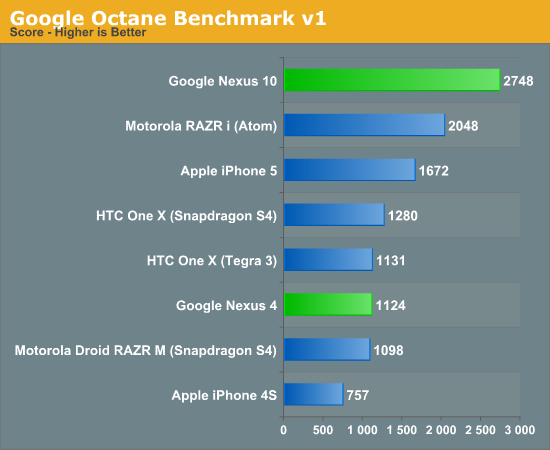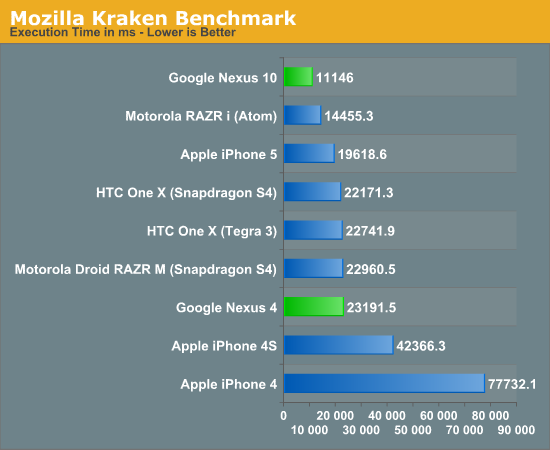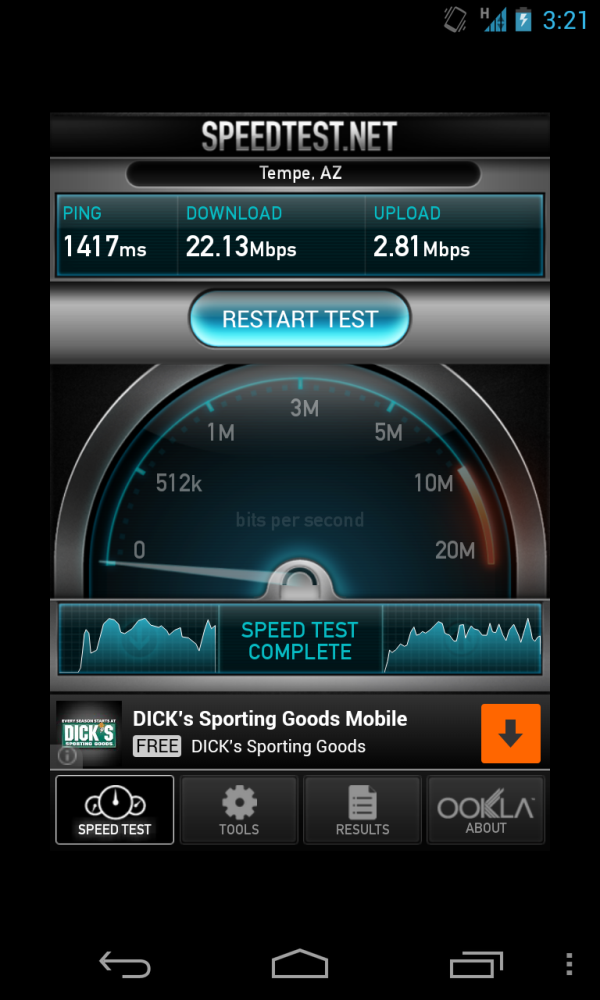Google Nexus 4 and Nexus 10 Performance Preview
by Anand Lal Shimpi & Brian Klug on November 2, 2012 11:00 AM ESTEarlier this week Google announced two new flagship Nexus devices: the Nexus 4 smartphone and the Nexus 10 tablet. We received review samples of both earlier this week, and while we're hard at work at full reviews of the devices we couldn't help but share all of the test data we've been able to amass at this point.
For those who aren't familiar with it, the Nexus 4 features Qualcomm's Snapdragon S4 Pro SoC - a quad-core 28nm Krait CPU with Qualcomm's next-generation Adreno 320 GPU. The combination proved quite formidable in the MDP/T we tested, as well as LG's recently announced Optimus G. The SoC drives a 4.7-inch 1280 x 768 IPS display and is paired with 2GB of LPDDR2 memory. The Nexus 4 ships unlocked with 8GB of NAND for $299 without a contract ($349 for the 16GB version). Pair that with DC-HSPA+ support and you get an absolute killer smartphone for use on T-Mobile: no contracts, very low monthly fees, and compelling cellular performance:
Brian will talk more about the combination in his full review, but rest assured that the lack of LTE is workable depending on T-Mobile coverage where you live/travel to.
The Nexus 10 also boasts a brand new SoC: Samsung's Exynos 5 Dual. The Exynos 5 Dual features two ARM Cortex A15 cores running at 1.7GHz as well as ARM's own Mali-T604 GPU. This happens to be the exact same platform used in the new Chromebook, just running Android. The Nexus 10 features a 10.1-inch 2560 x 1600 display, giving it the same resolution as the 13-inch MacBook Pro with Retina Display - but in an even smaller form factor. Google is also aggressive on Nexus 10 pricing: the 16GB WiFi-only tablet sells for $399, with the 32GB version going for $499.
Both Nexus devices run Android 4.2 and are guaranteed to be the first devices to be updated to upcoming Android revisions for the foreseeable future (it's the power of Nexus).
We haven't had a ton of time to test the devices and put this together so you're going to see combined performance charts throughout the rest of this article.
CPU Performance
The big story when it comes to CPU performance is a look at how the Cortex A15s perform under Android. Unfortunately we're still left with mostly browser based benchmarks to measure CPU performance, which actually highlights a major issue in our testing: Android V8 optimization doesn't seem to be anywhere near as good as it is under Chrome OS or Windows. As a result, all of the Nexus 10 performance scores end up slower than the new Chromebook - despite using the same SoC and running Chrome on both platforms. It's also possible that the Exynos 5 Dual in the Chromebook is allowed to burn a bit more power, translating to better performance, but either way the solution here in the Nexus 10 doesn't look as good across the board.

SunSpider performance is good, but not significantly better than Qualcomm's Krait based Snapdragon S4. Both the iPhone 5 and RAZR i are able to outperform the Nexus 10. The S4 Pro based Nexus 4 tends to be in line with other S4 based devices - SunSpider doesn't really give much credit to the extra 2 cores.

BrowserMark puts the Nexus 10 behind many platforms that should be faster, I'm even wondering here if there's some hard partitioning of memory bandwidth between the CPU and GPU to drive the 2560 x 1600 display that's simply choking the CPU here.
The Nexus 4 does ok, but again there seem to be some V8 optimization issues at work here under Android 4.2. At 1.5GHz it should deliver at least the performance of the dual-core Snapdragon S4 solutions.

Octane is the first test where the Cortex A15s are really able to flex their muscle - the Exynos 5 Dual based Nexus 10 manages to outperform the RAZR i by 34%, and compared to the A6/Swift based iPhone 5 the advantage grows to 64%.
The Nexus 4 performs about in line with other Snapdragon S4 based devices, although once again the extra 2 cores don't seem to be doing much for it here at all.

Kraken also paints the Cortex A15 based Nexus 10 in a good light: there's a 30% advantage over the RAZR i and a 76% advantage over the iPhone 5. These numbers will shrink a bit compared to other tablets, but not by much. The Nexus 4, once again, ends up performing similarly to dual-core Snapdragon S4 based devices.
Overall, the Nexus 10 results show us some real promise for what we can expect from ARM Cortex A15 based SoCs. The potential upside to this new architecture is huge.

















244 Comments
View All Comments
nmPraveen - Friday, November 2, 2012 - link
Add iPad4 benchmark values too.PeteH - Friday, November 2, 2012 - link
iPad4 just came out today, so it hasn't been benchmarked yet.doobydoo - Saturday, November 3, 2012 - link
When did the Nexus 10 come out?firesyde424 - Friday, November 2, 2012 - link
I get the general idea that, for whatever reason, it's fairly difficult to get anything more than a ballpark idea about relative speed when comparing smartphones. For instance, most of AT's benchmarks show the US version of the HTC One X as faster than the international version. Having had both of them sitting next to each other, my benchmarks don't bear that out. My benchmarks show the Internation version as considerably faster in cpu tests and in gpu tests, the two were roughly even.Even in this article, my Octane score for the Int S3 and Int HOX were 3-400 points higher than AT has listed here. I'm not saying that AT's scores are invalid. My gripe is that there doesn't seem to be a lot of consistency in the mobile computing space yet. Hopefully that changes with further generations of smartphones.
nidz1 - Friday, November 2, 2012 - link
I'll take these benchmarks with a grain of salt. My Galaxy Nexus on 4.1.2, running the stock kernel, with no overclocking, receives a 1601ms in Chrome, and 1420ms in the AOSP browser. I receive a 113031 on Chrome in browsermark, and a 133981 with the AOSP browser.I'm indifferent in regards to the GPU benchmarks, because I'm able to play all current games on my Gnex with no noticeable lag. Once the software issues with the Nexus 4 are sorted out, I'm sure it will be noticeably better than my Galaxy Nexus. I'll still probably pick up a Nexus 4, if I like the screen, because one year of service with T-Mobile & a Nexus 4 only costs $660, which is the price of a SGS3, One X+, or iPhone 5.
Aenean144 - Friday, November 2, 2012 - link
Have some perspective guys. For all intents and purposes, you can mix and match most of these ARM smartphones and tablets as they use the same platform. In most of these cases, it's basically the same SoC.For GPU benchmarks, you must always keep the native resolution in mind when interpreting scores.
For CPU javascript benchmarks, it's basically the best we got to compare across platforms. It's highly sensitive to the browser and its JIT compiler, so it's typically best to compare across the same platform and browser version for those. They'll do linpack and others eventually, but that'll take time. If SpecINT and SpecFP could be ported, I'm sure they'll use those.
Ideally, Anandtech could write its own benchmark code and compile them for each platform, but that'll take time and effort they likely don't have. I'm sure they won't mind if someone else develops the code.
MadMan007 - Saturday, November 3, 2012 - link
AT is not some rinky dink website run out of someone's paretn's basement. Have you seen Anand's home theater and house? He makes enough money from AT to pay for a dev if he wants to.Aenean144 - Tuesday, November 6, 2012 - link
Anandtech is like 3 or 4 guys, and they do lots of reviews on other hardware. The work to do this is not trivial, the benchmark software is not consistent across platforms and sometimes not consistent within platform versions. Every time a new benchmark is developed, a lot of devices have to be rerun. It's a rather difficult problem to continuously rerun benchmarks and make sure everything is consistent. It isn't going to happen fast, and there won't be a broad swath of hardware they'll have benchmarks on.Take the benchmarks for what they are worth. They are there to characterize the performance of the platform. If you want to compare who's the winner between platform A versus platform B, the tools really aren't there to precisely do that.
Impulses - Friday, November 2, 2012 - link
Looks like the S4 Pro was shoehorned pretty hard into a phone, kinda ironic considering the last two Nexus phones didn't really feature a SoC that was any better than what was on the market already (and people criticized them for it, now it may be the other way around). Shouldn't Qualcomm have a dual core Krait w/the new Adreno coming out towards year's end/next year?Mumrik - Friday, November 2, 2012 - link
I simply don't get it. Do people really care if their phone is 9mm thick or 1.1cm?Give me a bit more thickness and a much larger battery. Motorola has it right with those MAXX phones and they aren't thick.